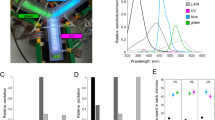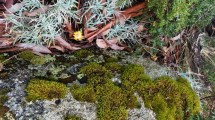Abstract
Intensity discrimination experiments are performed with individual walking honeybees trained to color stimuli (UV, blue and green) of constant intensity. The choice behavior to stimuli of identical wavelength spectrum but different intensities is tested. A graded choice behavior is found. The training intensity is chosen with the highest probability in most cases. Phototaxis as well as brightness discrimination can be excluded. The choice behavior is explained exclusively by discrimination of chromaticness (hue and saturation) according to the Bezold-Brücke shift.
The bees adapt to the chromatic stimuli during their choices. From the behavioral data, it is concluded that in adaptation, adjustment in photoreceptor sensitivity in one receptor also affects the sensitivity of the other receptors (“co-adaptation”). The linear adaptation model corresponding to the von Kries Coefficient Law used up to now to describe adaptation to white light in the honeybee does not describe this type of adaptation.
A quantitative model of adaptation to chromatic stimuli extending the linear adaptation model is developed.
The most reasonable mechanism of co-adaptation is optical coupling by lateral filtering. Other mechanisms such as electrical coupling are unlikely, since their effects on color vision would lead to effects inconsistent with Graßmann's Laws.
Similar content being viewed by others
References
Alpern M (1972) Eye movements. In: Jameson D, Hurvich LM (eds) Handbook of sensory physiology, vol VII/4. Springer, Berlin Heidelberg New York, pp 303–330
Autrum H (1981) Light and dark adaptation in invertebrates. In: Autrum H (ed) Handbook of sensory physiology, vol VII/6C. Springer, Berlin Heidelberg New York, pp 1–91
Backhaus W (1991) Color opponent coding in the visual system of the honeybee. Vision Res 31: 1381–1397
Backhaus W (1992) The Bezold-Brücke effect in the color vision system of the honeybee. Vision Res 32: 1425–1431
Backhaus W (1993) Color vision and color choice behavior of the honeybee. Apidologie 24: 309–331
Backhaus W, Menzel R (1987) Color distance derived from a receptor model of color vision in the honeybee. Biol Cybern 55: 321–331
Backhaus W, Menzel R, Kreißl S (1987) Multidimensional scaling of color similarity in bees. Biol Cybern 56: 293–304
Bader CR, Baumann F, Bertrand D (1976) Role of intracellular calcium and sodium in light adaptation in the retina of the honey bee drone (Apis mellifera L.). J Gen Physiol 67: 475–491
Bernard DG, Wehner R (1980) Intracellular optical physiology of the bee's eye. I. Spectral sensitivity. J Comp Physiol 137: 193–203
Bezold W von (1873) Über das Gesetz der Farbenmischung und die physiologischen Grundfarben. Ann Phys Chem 150: 221–247
Brandt R, Backhaus W, Dittrich M, Menzel R (1993) Simulation of threshold spectral sensitivity according to the color theory for the honeybee. In: Elsner N, Heisenberg M (eds) Proc 21th Göttingen Neurobiol Conf. Thieme, Stuttgart, p 374
Brücke EW (1852) Untersuchungen über subjektive Farben. Akad Wiss Wien, math-nat Kl 3: 95–108 (also published in 1952: Archs Sci Phys Nat 19: 121–135)
CIE (1987) International light vocabulary. Publication CIE No 17.4. Bureau Central de la Comission Electrotechnique Internationale, Geneva
Dittrich M (1995) Time course of color induction in the honeybee. J Comp Physiol A 177: 207–217
Graßmann H (1853) Zur Theorie der Farbenmischung. Ann Phys Chem 89: 69–84
Helversen O von (1972) Zur spektralen Unterschiedsempfindlichkeit der Honigbiene. J Comp Physiol 80: 439–472
Henderson ST (1970) Daylight and its spectrum. Hilger, London
Howard J, Blakeslee B, Laughlin SB (1987) The intracellular pupil mechanism and photoreceptor signal: noise ratios in the fly Lucilia cuprina. Proc R Soc Lond B 231: 415–435
Kolb G, Autrum H (1974) Selektive Adaptation und Pigmentwanderung in den Sehzellen des Bienenauges. J Comp Physiol 94: 1–6
Kries J von (1904) Die Gesichtsempfindungen. In: Nagel W (ed) Handbuch der Physiologie des Menschen, Vol 3. Vieweg, Braunschweig, pp 109–282
Labhart T (1974) Behavioral analysis of light intensity discrimination and spectral sensitivity in the honey bee, Apis mellifera. J Comp Physiol 95: 203–216
Lamb TD, Pugh EN (1992) G-protein cascades: gain and kinetics. Trends Neurosci 15: 291–298
Langer H (1975) Properties and functions of screening pigments in insect eyes. In: Snyder AW, Menzel R (eds) Photoreceptor optics. Springer, Berlin Heidelberg New York, pp 429–455
Laughlin SB, Hardie RC (1978) Common strategies for light adaptation in the peripheral visual systems of fly and dragonfly. J Comp Physiol 128: 319–340
Lipetz LE (1971) The relation of physiological and psychological aspects of sensory intensity. In: Loewenstein (ed) Handbook of sensory physiology, vol I. Springer, Berlin Heidelberg New York, pp 191–225
Menzel R (1967) Untersuchungen zum Erlernen von Spektralfarben durch die Honigbiene (Apis mellifica). Z Vergl Physiol 56: 22–62
Menzel R (1981) Achromatic vision in the honeybee at low light intensities. J Comp Physiol 141: 389–393
Menzel R, Backhaus W (1989) Color vision in honeybees: phenomena and physiological mechanisms. In: Stavenga DC, Hardie RC (eds) Facets of vision. Springer, Berlin Heidelberg New York, pp 281–297
Menzel R, Backhaus W (1991) Colour vision in insects. In: Gouras P (ed) Vision and visual dysfunction. MacMillan, London, pp 262–293
Menzel R, Greggers U (1985) Natural phototaxis and its relation to color vision in honeybees. J Comp Physiol A 157: 311–321
Menzel R, Ventura DP, Werner A, Joaquim LCM, Backhaus W (1989) Spectral sensitivity of single photoreceptors and color vision in the stingless bee, Melipona quadrifasciata. J Comp Physiol A 166: 151–164
Roebroek JGH, Stavenga DG (1990a) On the effective optical density of the pupil mechanism in fly photoreceptors. Vision Res 30: 1235–1242
Roebroek JGH, Stavenga DG (1990b) Insect pupil mechanisms. IV. Spectral characteristics and light intensity dependence in the blowfly, Calliphora erythrocephala. J Comp Physiol A 166: 537–543
Sachs L (1984) Angewandte Statistik, 6 edition. Springer, Berlin Heidelberg New York
Shaw SR (1975) Retinal resistance barriers and electrical lateral inhibition. Nature 255: 480–483
Snyder AW (1975) Photoreceptor optics — theoretical principles. In: Snyder AW, Menzel R (eds) Photoreceptor optics. Springer, Berlin Heidelberg New York, pp 38–55
Stavenga DG (1979) Pseudopupils of compound eyes. In: Autrum H (ed) Handbook of sensory physiology, vol VII/6A. Springer, Berlin Heidelberg New York, pp 357–439
Stavenga DG, Kuiper JW (1977) Insect pupil mechanisms. I. On the pigment migration in the retinula cells of Hymenoptera (suborder Apocrita). J Comp Physiol 113: 55–72
Stieve H (1984) Biophysik des Sehvorganges. Phys Bl 40: 205–211
Tsukahara Y, Horridge GA (1977) Interaction between two retinula cell types in the anterior eye of the dronefly Eristalis. J Comp Physiol 115: 287–298
Yarbus AL (1967) Eye movement and vision. Plenum, New York
Author information
Authors and Affiliations
Rights and permissions
About this article
Cite this article
Dittrich, M. A quantitative model of successive color induction in the honeybee. J Comp Physiol A 177, 219–234 (1995). https://doi.org/10.1007/BF00225101
Accepted:
Issue Date:
DOI: https://doi.org/10.1007/BF00225101




